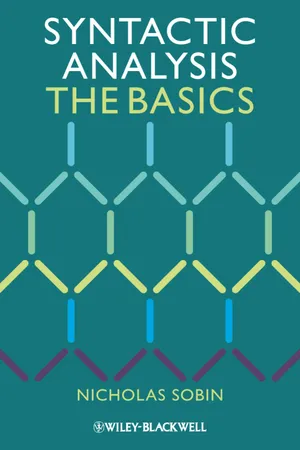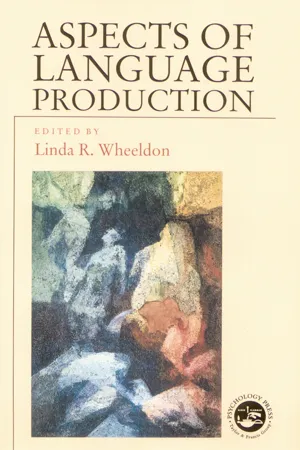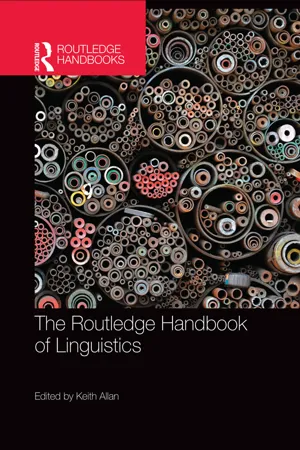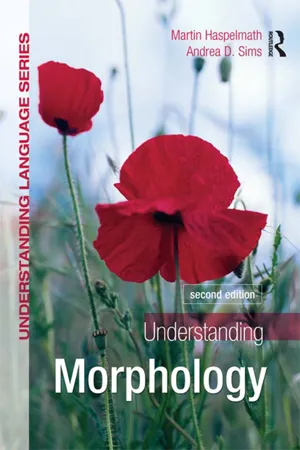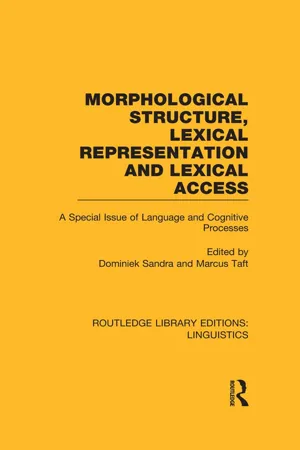Languages & Linguistics
Prefix
A prefix is a linguistic element added to the beginning of a word to modify its meaning. It is a type of affix, and in many languages, including English, prefixes are widely used to create new words or alter the meaning of existing ones. Prefixes can indicate aspects such as negation, location, time, quantity, or intensity.
Written by Perlego with AI-assistance
Related key terms
Related key terms
1 of 4
Related key terms
1 of 3
8 Key excerpts on "Prefix"
- eBook - ePub
Syntactic Analysis
The Basics
- Nicholas Sobin(Author)
- 2010(Publication Date)
- Wiley-Blackwell(Publisher)
Roots are the core morphemes that a word is built on. Suffixes are endings that follow a root. Roots may be free or bound. A free root can appear as a word on its own (e.g. book or walk). A bound root cannot. Most English roots are free, but this is often not true of other languages. In Spanish, verb roots are bound – they always appear with an ending of some sort. For instance, the Spanish verb jugar ‘(to) play’ in its various forms always minimally involves (a form of) the root jug and some suffix – the root can never be said by itself. The morphemes that attach to roots to form complex words (words of more than one morpheme) are called affixes. They include suffixes, Prefixes, infixes, and circumfixes. Prefixes such as un- in the word untangle precede the root. Infixes actually intrude into the root – English has no examples of this, so we won't worry about them here. English used to have circumfixes, a simultaneous Prefix–suffix combination, and modern German still does. For instance, one form of the German verb machen ‘(to) make’ (root: mach ; infinitive suffix: -en) is the word gemacht ‘made’ (past participle form), containing the root and the past participle circumfix ge - - t. Affixes are bound – they do not occur as words by themselves. Now if the lexicon is a list of roots and affixes, how do these get together to form complex (multi-morphemic) words? A partial answer may lie in considering affixes in more detail. 2.5 Affix Types Two prominent types of affix exist in the lexicon: inflectional affixes and derivational affixes. Inflectional affixes simply give you all of the different forms that a word of a given lexical category can appear in. For example, a verb has five possible forms, as illustrated in (6) - eBook - ePub
- Linda Wheeldon(Author)
- 2013(Publication Date)
- Psychology Press(Publisher)
12 Any or all of the morphological characteristics such as position with respect to the root, predictability, productivity, frequency, consistent semantics, morpheme type, and morphological system type might contribute to categories of lexical representations. Here, data from an ergative language with inflectional Prefixes are presented, with a view of trying to expand the morphological set of inquiry, as well as to separate possible morphological properties that might be relevant to categories of lexical representation.Tzotzil, a Mayan language of Mexico, is a highly inflected language that uses Prefixes to encode information about aspect, person, and subject vs. object. (All data and analyses of Tzotzil in this section are from Aissen, 1987.) Prefixes are used to mark neutral, incompletive, and completive aspect, as illustrated in (14) (Aissen, 1987, pp. 41–42):(14) (a) neutral aspect: x- Mu x- bat. not aspect-go He/she/it/they isn’t/aren’t going. (b) incompletive aspect:13 ta + x-Ta x- bat. aspect aspect-go particle He/she/it/they is/are going. (c) completive aspect: ʔ i-ʔ i- bataspect-go He/she/it/they went. In all of the languages examined in the production and processing literature to date, (regular) inflectional affixes are assumed to be a homogenous class of affixes suffixed to the root. But since several researchers have argued that suffixes and Prefixes get different kinds of processing or representation in the mental lexicon (e.g., Cutler, Hawkins, & Gilligan, 1985), the presence of inflectional Prefixes becomes relevant to the representation of inflections in the mental lexicon. With the inclusion of inflectional Prefixes into the field of study, we would be able to separate the possible factors of position with respect to the root versus affix type as contributors to mental representations and processes. - eBook - ePub
- Keith Allan, Keith Allan(Authors)
- 2015(Publication Date)
- Routledge(Publisher)
help .Word formation by means of affixation means that an affix is added to a base form. The affix can appear before the base word (Prefixation), after the base word (suffixation), or, far more rarely, within the base word. Examples of English Prefixes are un – and re –. The negative Prefix un – can attach to verbs (un-do ), adjectives (un-kind ) and nouns (un-belief ). The suffix re – attaches to verbs (and may also appear in nouns and adjectives derived from such verbs), as in re-do and re-use . An example of suffixation is the addition of the suffix –able to a verb for making adjectives, as in do-able and re-us-able . An example of infixation is the use of fucking and goddamn as pejorative infixes in words like un-fucking-believable and in-goddamn-consistent .Compounding is an intensively studied word formation process, as can be seen from a recent handbook on compounding (Lieber and Stekauer 2009). Its defining property is that two or more words (in the sense of lexemes) are concatenated. The form of the lexeme used is often the stem form. In English there is no phonological difference between a concrete word and its stem: a word like dog is both a concrete word and a stem, as in dog food . However, in many languages stems do not occur as words by themselves, and must be supplemented by an overt inflectional ending for their use of concrete words in a sentence. For example, in Modern Greek the compound for ‘deer hunter’ is elaf-o-kinig-os . The first constituent is the stem form of elafi ‘deer,’ without its inflectional ending –i . This stem is followed by a linking element –o –, a meaningless constituent, and is then followed by the head constituent kinig-os . The inflectional ending on the second stem kinig –, –os - eBook - ePub
- Kristin Denham, Anne Lobeck(Authors)
- 2018(Publication Date)
- Routledge(Publisher)
4 The study of words MorphologyLet’s now consider how we study speakers’ unconscious knowledge of word structure. In Chapter 2 , in the ‘Our knowledge of grammar’ section, we briefly discussed how our knowledge of word structure, or morphology, includes knowledge of morphemes, or parts of words, and of affixation (suffixes and Prefixes in English for example, and the roots and words they attach to). We also have knowledge of word formation rules such as clipping, blending, backformation, compounding, etc.As we will see in this chapter, languages don’t necessarily share the same morphological rules. Consider, for example, one type of word formation that doubles a part of the word (called reduplication) that occurs in Lushootseed, a language of the Pacific Northwest (adapted from Hess & Hilbert, 1995):ʔálʔal house ʔáʔálʔal hut ʔúqw’ ud pull out ʔúʔúqw’ ud pull part way out híwil go ahead híhíwil go on ahead a bit q’íxw upstream q’íq’íxw a little bit upstream The first two sounds of a word are doubled in order to make a diminutive: the ʔá of the word for house is doubled to make hut: ʔáʔálʔal.As we will also see in this chapter, there is much more to the study of morphology than making words. In fact, the question What is a word? is actually quite difficult to answer, because not all languages build words in the same way, yet speakers share some kind of common knowledge that allows them to recognize what is and what is not a possible word in their language.MorphemesA morpheme is often described as the smallest unit of meaning in a word. This suggests that there are two morphemes in the word pancake, namely, pan and cake, both of which have rather obvious, recognizable meanings, and both of which are words by themselves. Other morphemes have meaning too, though perhaps not in the dictionary sense. English speakers would probably all agree that there are three morphemes in waspishness (wasp, -ish, and -ness). We can say that the morphemes -ish and -ness have meaning because we recognize them as parts of words we easily combine with other parts to create other words, such as pinkish and happiness. We also know that although -ish and -ness can attach to adjectives such as pink and happy, these suffixes can’t attach to verbs such as run or work to create *runnish or *workness. So, although we might have difficulty defining the term word - eBook - ePub
- Martin Haspelmath, Andrea Sims(Authors)
- 2013(Publication Date)
- Routledge(Publisher)
’ , etc.).(2.6) Russian case inflection (singular forms) nominative ruk-a ‘ hand’ accusative ruk-u genitive ruk-i dative ruk-e locative ruk-e instrumental ruk-oj
(Sullivan 1988: 26)(2.7) Nahuatl possessor inflection 1SG no-cal ‘ my house’ 2SG mo-cal ‘ your (SG ) house’ 3SG i-cal ‘ his/her house’ 1PL to-cal ‘ our house’ 2PL amo-cal ‘ your (PL ) house’ 3PL in-cal ‘ their house’ Morphologists often use special terms for different kinds of affixes, depending on their position within the word. Affixes that follow the main part of the word are called suffixes (e.g. the Russian case suffixes in (2.6)), and affixes that precede it are called Prefixes (e.g. the Classical Nahuatl possessor Prefixes in (2.7)). The part of the word that an affix is attached to is called the base, e.g. ruk- in Russian, or -cal in Classical Nahuatl. Affixes and bases can, of course, be identified both in inflected word-forms and in derived lexemes. For instance, in read-er, read-able and re-read, read is the base, -er and -able are suffixes, and re- is a Prefix. A base is also sometimes called a stem, especially if an inflectional (as opposed to derivational) affix attaches to it.There are still other kinds of affixes, besides Prefixes and suffixes, which are briefly described and illustrated in Table 2.1 .Types of affixes Examples suffix: follows the base Russian -a in ruk-a ‘ hand’ English -ful in event-ful Prefix: precedes the base Classical Nahuatl no -in no-cal ‘ my house’ English un- in unhappy infix: occurs inside the base Arabic -t- in (i)š -t-agala‘ be occupied’ - eBook - ePub
English Words
Structure, History, Usage
- Francis Katamba(Author)
- 2015(Publication Date)
- Routledge(Publisher)
This is important, as we will see in sections (11.2.2) and (11.4.1), not only for the way linguists describe language but also for the way in which the brain processes words. So the bases in road-s, government-s and schoolboy-s are all stems since they are followed by the plural inflectional suffix - s. Of course, the internal structure of these stems is different: road is a simple root, govern-ment is a complex one, containing as it does the derivational suffix - ment ; and schoolboy is also complex since it is a compound word. Although until now we have treated inflection and derivation separately, it does not mean that they are mutually exclusive. Both derivational and inflectional morphemes may be found in the same word. In that event, derivational morphemes are attached first and any inflectional morphemes are added later, as it were. That is why, when both inflectional and derivational morphemes are present, the inflectional morphemes are on the outer fringes of the word, as you can see in [4.13]. In other words, derivation can create the input to inflection. A new lexeme that has been yielded by derivation can subsequently undergo inflection in order to ensure that the word has the appropriate grammatical properties for the syntactic position in which it occurs. Similarly, if both compounding and inflection take place, as a rule compounding is carried out first. So, the inflectional morpheme is appended on the outer margins to the second element of the compound, which is on the right ([4.14a]) - eBook - ePub
English Words
A Linguistic Introduction
- Heidi Harley(Author)
- 2017(Publication Date)
- Wiley-Blackwell(Publisher)
5Pre- and Suf-fix-es: Engl-ish Morph-o-log-y/ˈpɹij ən ˈsʌfɪksəz ˈɪŋɡlɪʃ ˌmɔɹˈfɑlədʒij/In Chapter 1 we saw that there was a significant mismatch between independently meaningful units (listemes) and phonological words. One of the main reasons for this mismatch is that there are meaningful elements contained within phonological words. There are even some elements that are obviously regular subparts of words even though they aren’t independently meaningful. These subparts, whether independently meaningful or not, are called morphemes. We will look at the morphemes which make up English words in some detail in this chapter, learning about the processes of derivation and inflection. We will also learn about the ways affixation interacts with stress assignment and part of speech.5.1 Listemes
In Chapter 1 , we arrived at a distinction between listemes and phonological words. Phonological words are a unit of speech that may be made up of one (dog) or several (dogs) or no (caboodle) listemes. Listemes are the units that encode a sound-meaning connection – they are the things that are listed in the mind of a speaker of English.In the next three chapters, we’re going to try and discover something about what those listings must be like. If they encode a sound–meaning connection, they at least must include information about sound – how the listeme is pronounced – and information about meaning. Our first idea of a listeme, then, will be something like a dictionary entry. Here’s some first attempts at representations of listemes:Phonology Semantics /'kæt/ CAT, i.e. “four-legged animal, pointy upstanding ears, carnivore, domestic, furry, ‘meow’ noise” /'kIkðə'bΛkət/ “die” /əd/ “past tense” (Of course, the semantics part here is only approximate; we’ll refine it more in Chapter 7 .) So this is the minimal amount of information that we have to know about listemes.But of course we need to say more. Even though /əd/ means “past tense” in a verb like patt-ed - eBook - ePub
Morphological Structure, Lexical Representation and Lexical Access
A Special Issue of Language and Cognitive Processes
- Dominiek Sandra, Marcus Taft, Dominiek Sandra, Marcus Taft(Authors)
- 2014(Publication Date)
- Routledge(Publisher)
Their basic function is a syntactic one, conveying how a word (or the phrase to which it belongs) grammatically relates to other sentence parts (e.g. the German accusative form of the determiner in Er sah den Mann [he saw the man] signals that the noun phrase relates to the verb as direct object) or conveying grammatical agreement with other words (e.g. person agreement as in he plays, gender agreement as in der Mann [the man]). As inflected forms are syntactically constrained, it is understandable that major portions of the inflectional system of many languages are rule-governed, resulting in the predictability of regular inflected forms. Inflectional affixes are not tied to single lexical items but are part of a morphological paradigm, which is linked to a particular form class (e.g. verbs) and whose slots are defined in terms of syntactic properties (e.g. the inflectional suffix in plays fits within the present-tense paradigm and requires a thirdperson singular subject). Given these properties, it seems apt to treat regularly inflected forms outside the domain of lexical business, as different realisations of a single word (or lexeme). Thus considered, the hypothesis of a morphemic lexicon is highly plausible from the point of view of regularly inflected forms (Chomsky, 1965). The Impact of the Spelling System. Let us see whether the representational claim derived from this linguistic characterisation of inflectional morphology makes sense as far as its implications for the on-line processing of written words are concerned. At the level of the composition process, no problems would arise. The meaning of affixes in forms like boys and plays can be described as a simple semantic predicate, taking the stem meaning as its argument (PLURAL[BOY], PRESENT[PLAY]), and which would be interpreted by the semantic module in the language system (see Forster, 1979, for a structure of the language processor)
Index pages curate the most relevant extracts from our library of academic textbooks. They’ve been created using an in-house natural language model (NLM), each adding context and meaning to key research topics.
Explore more topic indexes
Explore more topic indexes
1 of 6
Explore more topic indexes
1 of 4
